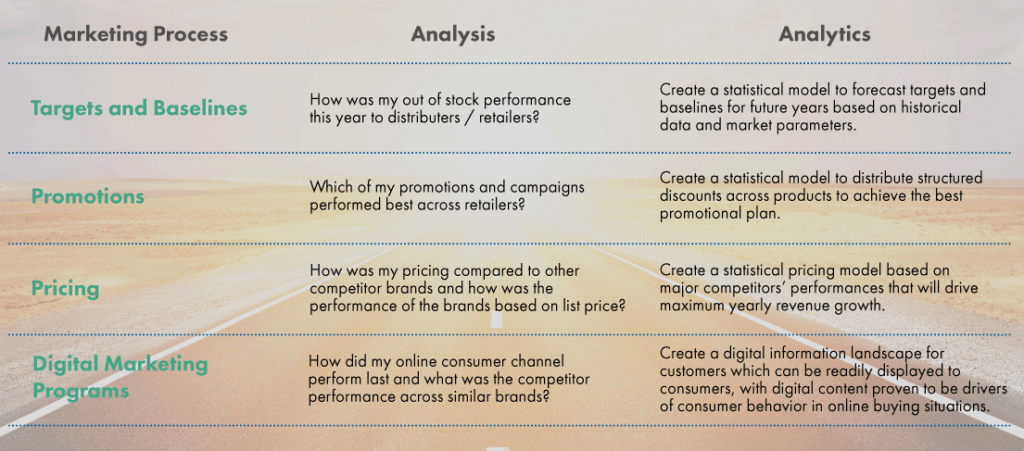What Every CPG Marketer Needs to Know About the Difference between Analytics & Data Analysis
Analytics has emerged as a catch-all term for a variety of different business intelligence (BI) initiatives. For some, it is the process of analyzing information from a particular domain, such as website analytics. For others, it is applying the breadth of BI capabilities to a specific content area (for example sales, customer service, and supply chain). Increasingly, the term “analytics” is used to describe statistical and mathematical data analysis that clusters, segments, scores, and predicts what scenarios are most likely to happen.
How is Analytics Different from Data Analysis?
The discipline of analytics is the discovery, interpretation, and communication of meaningful patterns in data. Analytics relies on the simultaneous application of statistics, computer programming, and operations research to quantify performance. Analytics often favors data visualization to communicate insight. Whereas analysis is a method of studying the nature of something or of determining its essential features and their relations.
Marketers leverage both to drive all types of decisions, and each specific application supports the unique insight challenges inherent in dissecting customer behaviors. One way to distinguish the difference between analysis and analytics is to think in terms of past and future. Analysis looks backwards over time, providing you with a historical view of what has happened. Typically, analytics look forward to model the future or predict a result.
Both analysis and analytics provide the insight marketers use to value customers accurately, target the right audience, and improve the effectiveness of their marketing budget. And both help transform customer data by exploring and analyzing that data to help uncover unknown patterns, opportunities, and insights that can drive proactive, evidence-based decision making.
What are the use cases for data analysis?
Data analysis will answer questions such as:
- How many customers responded to my offer?
- How did my campaign perform over all?
- How many new loyalty program sign-ups did we get last year?
- How did my marketing program perform?
Data analysis empowers us to slice and dice the same data in different ways providing micro views to reveal deeper customer insights. A typical report may produce the number of customer messages sent, the number customers responding, the response rate, and the revenue generated from the campaign. But, through careful analysis a marketer can learn how customers responded by segment, by store, and by geography by drilling deeper to understand customers at a more individual level. Analysis also helps marketers understand how their programs are impacting customer KPIs.
You likely use many types of analyses, including customer segmentation, attrition drivers, and market-basket analysis. Business intelligence tools support the drill down requirements marketers need to glean these insights. However, more common is a query process where reporting goes back and forth between the technology and marketing teams until an insight surfaces.
What are the use cases for analytics?
Analytics can be described as the method of logical analysis, typically performed through use of algorithms, which are applied as the “advanced logic” separation of the whole into component parts. This applied logic yields a more comprehensive result based on statistical relevance and helps the marketer by modeling what will happen next or by forecasting what will happen if a trend continues. For example, advanced segmentation strategies use analysis to group customers based on multiple past behaviors.
Customer retention can be improved by then using analytics to predict which customers are in danger of defecting. Predicting the next best product or service can increase revenue and profitability per customer, as well as increase relevancy of your message. Recommendation engines, like we see on many eCommerce sites today, are a form of predictive analytics. Just as you use analysis to understand which customers are responding to marketing programs, recommendation engines can use analytics to predict which customers are most likely to respond, thereby optimizing the marketing budget.
Sophisticated predictive analytics software tools best support these efforts and are typically used by trained statisticians versus the marketing practitioner. While analysis and business intelligence tools support ongoing daily analysis, analytics tend to be outsourced as special projects, unless an in-house capability is available.
How can this be applied to marketing?
Below are a few examples of the difference between data analysis and analytics for specific marketing use cases:
Which is Most Important for a Marketer?
While analytics is the method needed to better predict customer behaviors, analysis is the process required to answer key strategic questions, and both are important to the marketer.
By combining analytics and analysis, marketers can achieve a better understanding of their customers. Using analytics to dissect customer data, you can identify behaviors and trends and formulate more relevant, targeted offers and communications to address those trends. With analysis, marketers are able to evaluate the results of their efforts and apply these insights to determine success or make changes. As an organization, are you doing analysis, analytics, or both? If you are just doing analysis, considering looking at pilot projects you could run to test your analytics capabilities.
To learn more about the value of driving actionable analytics in your consumer products organization, read our Consumer Products Trends report.
Subscribe to Clarkston's Insights
Dr. Santanu Guha, a trade analytics and ROI optimization consultant, was a key contributor to this research.




